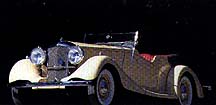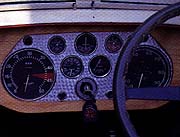The Auto Channel - "Sports Bastards" Sports Car International V12 I1
 Henry Rasmussen photos |
Michael Lamm didn't coin the phrase describing prewar hybrids, but he knows a thing or two about Railton, their premier example.
|
|

|
THOSE OTHER BASTARDS
 These were quick, handsome roadsters with better performance and handling than their modest prices gave them any right to have; Clark Gable even owned a 1936 Jensen-Ford for a time.
These were quick, handsome roadsters with better performance and handling than their modest prices gave them any right to have; Clark Gable even owned a 1936 Jensen-Ford for a time.  Not all Jensens were Ford-powered, though; some used Nash straight-8s or flathead Lincoln Zephyr V12s - an engine more renowned for its cylinder count than its actual capability.
Not all Jensens were Ford-powered, though; some used Nash straight-8s or flathead Lincoln Zephyr V12s - an engine more renowned for its cylinder count than its actual capability.

 Because the roadsters were heavier than the Railtons, Brough offered a supercharger.
The final model was the Type XII Saloon, which again used a Lincoln Zephyr V12.
Because the roadsters were heavier than the Railtons, Brough offered a supercharger.
The final model was the Type XII Saloon, which again used a Lincoln Zephyr V12.
RAILTON THE ENGINEER
- Between the wars, as the British empire crumbled, its aristocracy bumbled and the pound sterling tumbled, the average citizen of England was primed and eager for any sign that his once-invincible island could still beat the world at something_anything. Oddly enough, that something turned
out to be the World Land Speed Record (LSR).
- It took just a handful of men to give Great Britain the satisfaction of being the fastest nation on wheels. Leaders in this pursuit were Malcolm Campbell, John Cobb, Parry Thomas, George Eyston and Reid Railton. Campbell, Cobb, Thomas and Eyston financed and drove the cars, while Railton engineered and built the most successful examples for Campbell and Cobb.
- Reid Railton was born in 1895 and studied at Rugby School and the University of Manchester; then, at age 20, he went to work for Leyland Motors. Leyland built only trucks in those days, which didn't much interest Railton, but he did meet and work for Leyland's chief experimental engineer, J.G. Parry Thomas. Thomas became Railton's mentor, and the topic that interested both men most was speed: They talked long into many nights about the various nuances of forcing more power from engines, about aerodynamics and gear ratios, tire compounds, fuels and all that it might take to boost the LSR with a British machine.
- Both Parry Thomas and Railton left Leyland in 1923 to start businesses of their own: Thomas to pursue the LSR personally and Railton to build the Arab automobile, a line of small sports-racers. Thomas did capture the LSR in 1926 with a car he cobbled together from a WWI Liberty aircraft engine stuffed into an old Mercedes chassis, a contraption he called Babs. Malcolm Campbell beat Thomas' record the next year, whereupon Thomas fired up Babs once more on a long, flat beach at Pendine Sands, Wales, and was killed when Babs came unraveled.
- Reid Railton arrived on the scene half an hour after the accident and was absolutely devastated. Railton said of Thomas later, "...such ability as I have as an engineer I owe entirely to his teaching." Railton subsequently took over Thomas' unfinished work and, in the process, began engineering and building LSR cars for customers - first for Campbell (the famous Bluebird) and then for John Cobb, in the form of the Napier-Railton.
- Railton's reputation for speed had already been set by the early 1930s, so it was natural for Noel Macklin to choose so famous a name to help sell his 1933 sports bastard. After the outbreak of WWII and the demise of the Railton automobile, Noel Macklin even began building a different sort of sports bastard for the British navy - small warships powered by American-made Hall-Scott engines. Through Macklin's connection, Railton was asked to become an engineer for the Hall-Scott Motor Co. in Berkeley, California; he took the job and, as a result, moved his family there in 1939. After the war, Reid Railton stayed in America. He continued his LSR work with John Cobb and Donald Campbell (Sir Malcolm's son) and also consulted for Hudson from 1948 to 1956. In 1977, Reid Railton passed away at the age of 82.- ML
SPECIFICATIONS
1937 Railton Tourer
General
Vehicle type: front-engine, rear-wheel-drive convertible
Structure: steel ladder frame (Hudson) with aluminum body panels over wooden framing (Carbodies)
Engine
Type: longitudinal straight-8, iron block and head (Hudson)
Displacement (cc): 4168
Compression ratio: 6.3:1
Horsepower (bhp @ rpm): 122 @ 4200 rpm
Intake system: one 2-bbl downdraft carburetor (Carter)
Valvetrain: two pushrod-operated sidevalves per cylinder
Transmission
Type: 3-speed manual (Hudson)
Final drive: 4.11
Dimensions
Wheelbase (in.): 116
Track, f/r (in.): 56/56
Length (in.): 186.6
Width (in.): 67.0
Suspension, brakes, steering
Suspension, front: radius arms with semi-elliptic leaf springs and friction shocks
Suspension, rear: live axle with semi-elliptic leaf springs and friction shocks
Steering type: worm and roller
Wheels (in.): 16x4
Tires (in.): 16x6.25
Brakes, f/r: 10-inch drum/10-inch drum
Performance
0-60 (sec.): 8.6
Top speed (mph): 92


